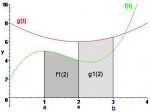just need to verify this.
if a have a function f(x) and a function g(x) and the area under f(x)
from a known a to a variable x is (integral from a to x of)f(x);
let f1(x)= (integral from a to x of)f(x);
and
the area under g(x) from the same variable x to a known b is
(integral from x to b of)g(x)
let g1(x)=(integral from x to b of)g(x);
now let c(x)= f1(x)+g1(x);
first isnt c the area of the two regions
and isnt
c'(x)(the derivative of c) the function of the curve above the two
regions(i.e region under f1(x) and region under g1(x))
between a and b?
Or at least if the function of the curve above the two
regions(i.e region under f1(x) and region under g1(x))
is fn(x)
isnt fn(b)=c'(b);
by second fundamental theorem of calculus
would be greatful for any reply.thanks
if a have a function f(x) and a function g(x) and the area under f(x)
from a known a to a variable x is (integral from a to x of)f(x);
let f1(x)= (integral from a to x of)f(x);
and
the area under g(x) from the same variable x to a known b is
(integral from x to b of)g(x)
let g1(x)=(integral from x to b of)g(x);
now let c(x)= f1(x)+g1(x);
first isnt c the area of the two regions
and isnt
c'(x)(the derivative of c) the function of the curve above the two
regions(i.e region under f1(x) and region under g1(x))
between a and b?
Or at least if the function of the curve above the two
regions(i.e region under f1(x) and region under g1(x))
is fn(x)
isnt fn(b)=c'(b);
by second fundamental theorem of calculus
would be greatful for any reply.thanks

